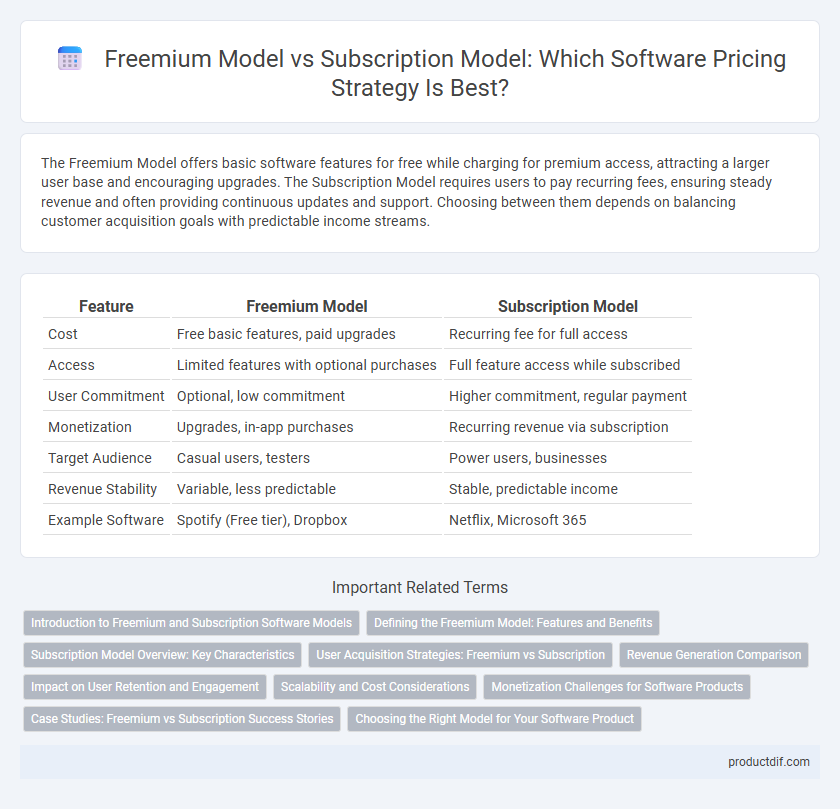The Freemium Model offers basic software features for free while charging for premium access, attracting a larger user base and encouraging upgrades. The Subscription Model requires users to pay recurring fees, ensuring steady revenue and often providing continuous updates and support. Choosing between them depends on balancing customer acquisition goals with predictable income streams.
Table of Comparison
| Feature | Freemium Model | Subscription Model |
|---|---|---|
| Cost | Free basic features, paid upgrades | Recurring fee for full access |
| Access | Limited features with optional purchases | Full feature access while subscribed |
| User Commitment | Optional, low commitment | Higher commitment, regular payment |
| Monetization | Upgrades, in-app purchases | Recurring revenue via subscription |
| Target Audience | Casual users, testers | Power users, businesses |
| Revenue Stability | Variable, less predictable | Stable, predictable income |
| Example Software | Spotify (Free tier), Dropbox | Netflix, Microsoft 365 |
Introduction to Freemium and Subscription Software Models
Freemium software models offer basic features for free while charging for premium functionalities, attracting a wide user base and encouraging upgrades. Subscription models provide continuous access to software through recurring payments, ensuring steady revenue and regular updates. Both models strategically balance user acquisition and monetization to maximize growth and profitability in the software industry.
Defining the Freemium Model: Features and Benefits
The freemium model offers basic software features at no cost while providing premium functionalities through paid upgrades, allowing users to experience the product before committing financially. This approach boosts user acquisition and engagement by lowering entry barriers and encouraging organic growth through word-of-mouth. Key benefits include rapid scaling potential, increased market reach, and a steady conversion funnel from free to paying customers.
Subscription Model Overview: Key Characteristics
The subscription model in software pricing features recurring payments at regular intervals, providing continuous access to services or applications. Key characteristics include predictable revenue streams, automatic updates, and scalable pricing tiers based on user needs or features. This model enhances customer retention by offering ongoing value and flexibility compared to one-time purchase options.
User Acquisition Strategies: Freemium vs Subscription
The freemium model drives user acquisition by offering free access to core software features, encouraging widespread adoption and viral growth through minimal entry barriers. In contrast, the subscription model prioritizes quality leads by requiring payment upfront, targeting users with higher commitment and willingness to pay. Combining freemium for mass attraction and subscription for premium conversion often maximizes both user base and revenue potential.
Revenue Generation Comparison
The Freemium model drives revenue by attracting a large user base through free access, converting a small percentage into paying customers via premium features, which can scale revenue with minimal upfront costs. The Subscription model generates steady, predictable income by charging users recurring fees for continuous access, providing greater revenue stability and higher lifetime customer value. While Freemium maximizes user acquisition and potential upsells, Subscription offers consistent cash flow and easier forecasting for long-term financial planning.
Impact on User Retention and Engagement
The freemium model drives user retention and engagement by offering basic features at no cost, encouraging users to explore and gradually upgrade as they recognize value, which fosters long-term loyalty. Subscription models ensure consistent engagement through recurring payments tied to continuous feature access and regular updates, creating a dependable revenue stream that supports ongoing product improvements. Data shows subscription models often result in higher user lifetime value (LTV) and more stable retention rates compared to freemium, which can suffer from large inactive user bases despite high initial acquisition.
Scalability and Cost Considerations
The freemium model offers scalability by attracting a large user base at minimal cost, allowing software companies to convert free users into paying customers gradually. In contrast, the subscription model provides predictable recurring revenue, which supports scalable infrastructure investment and continuous feature development. Cost considerations for freemium include managing free user churn and support expenses, while subscription models require balancing pricing tiers to maximize customer lifetime value and reduce attrition.
Monetization Challenges for Software Products
Freemium models often struggle with converting a significant portion of free users into paying customers, limiting revenue growth and making it difficult to sustain ongoing development costs. Subscription models face challenges in minimizing churn rates and justifying continuous value delivery to retain users over long periods. Both models require strategic pricing and feature differentiation to optimize monetization without alienating the user base.
Case Studies: Freemium vs Subscription Success Stories
Dropbox's freemium model attracted over 500 million users by offering essential storage for free while converting a significant percentage to premium plans with added features. Netflix's subscription model generated consistent revenue by providing unlimited streaming with tiered plans, achieving rapid global subscriber growth. Case studies reveal freemium excels in user acquisition, whereas subscription models drive predictable, scalable revenue streams.
Choosing the Right Model for Your Software Product
Selecting the right monetization strategy for your software product hinges on understanding user behavior and revenue goals; the Freemium Model attracts a broad audience with free features while generating income through premium upgrades, ideal for products seeking rapid user growth and market penetration. Conversely, the Subscription Model offers predictable revenue streams and fosters long-term customer relationships by providing continuous updates and exclusive content, suitable for software requiring ongoing value delivery. Evaluating factors like target market, product complexity, and budget constraints ensures the chosen model aligns with both user expectations and business sustainability.
Freemium Model vs Subscription Model Infographic

 productdif.com
productdif.com